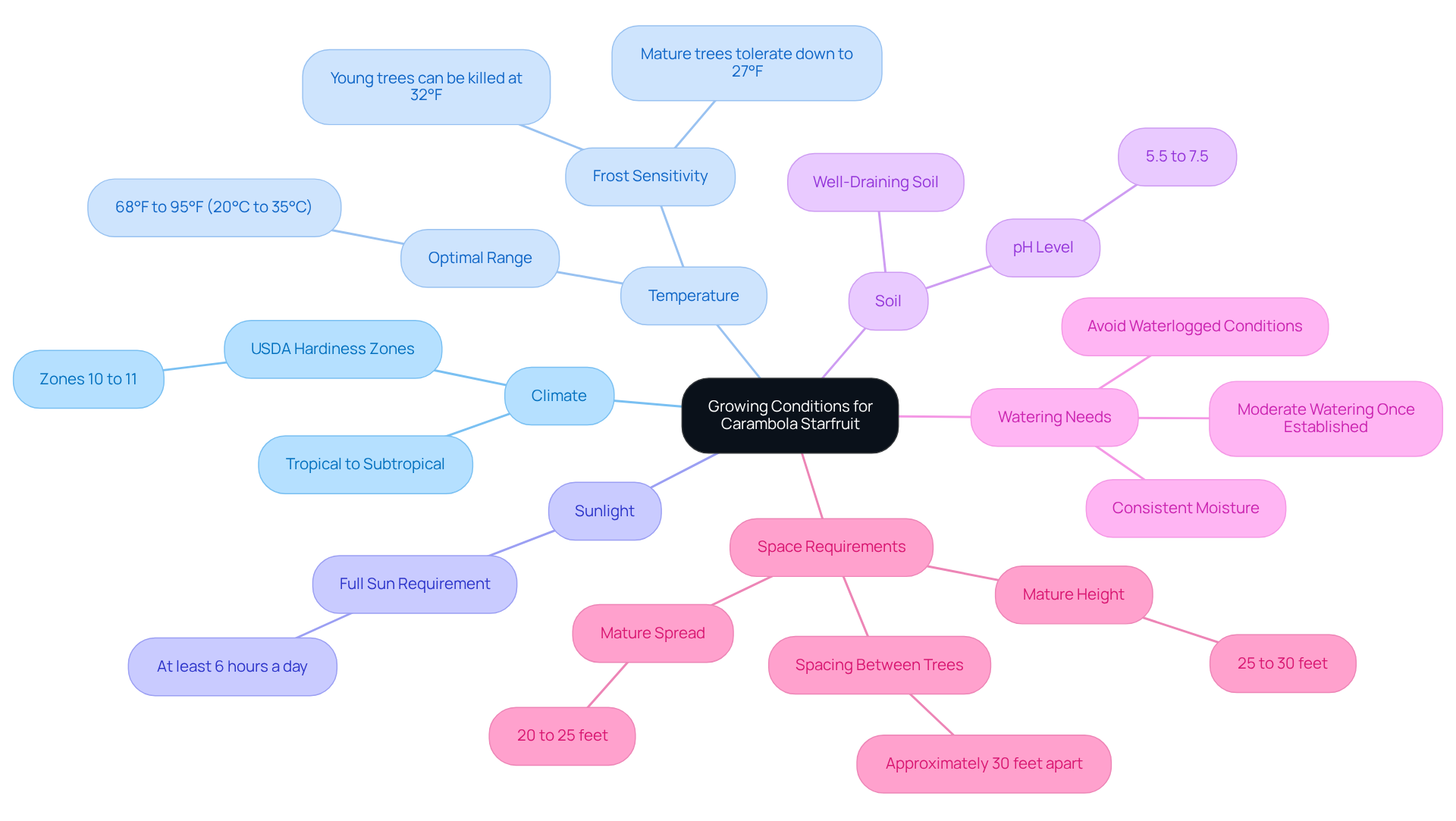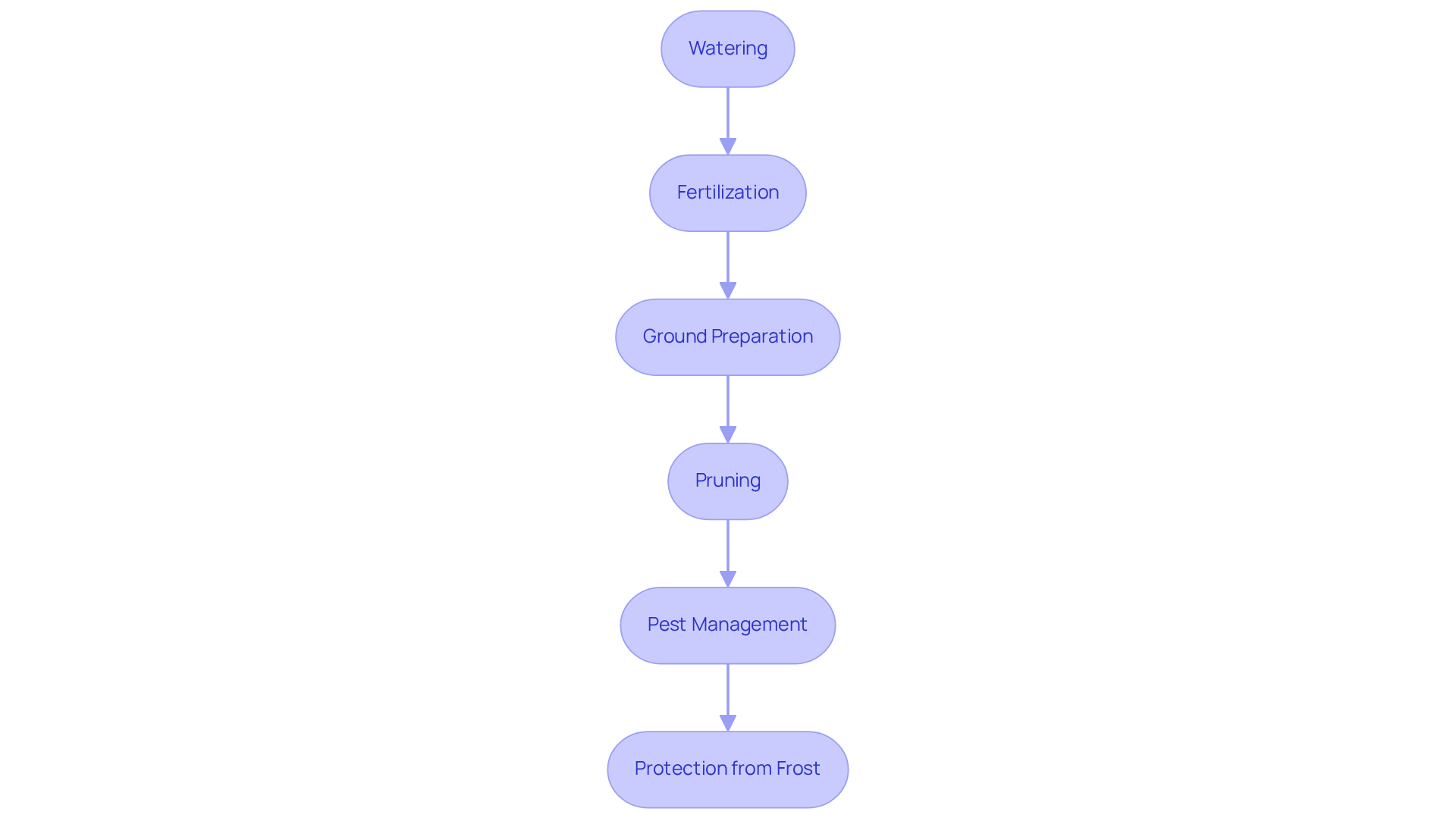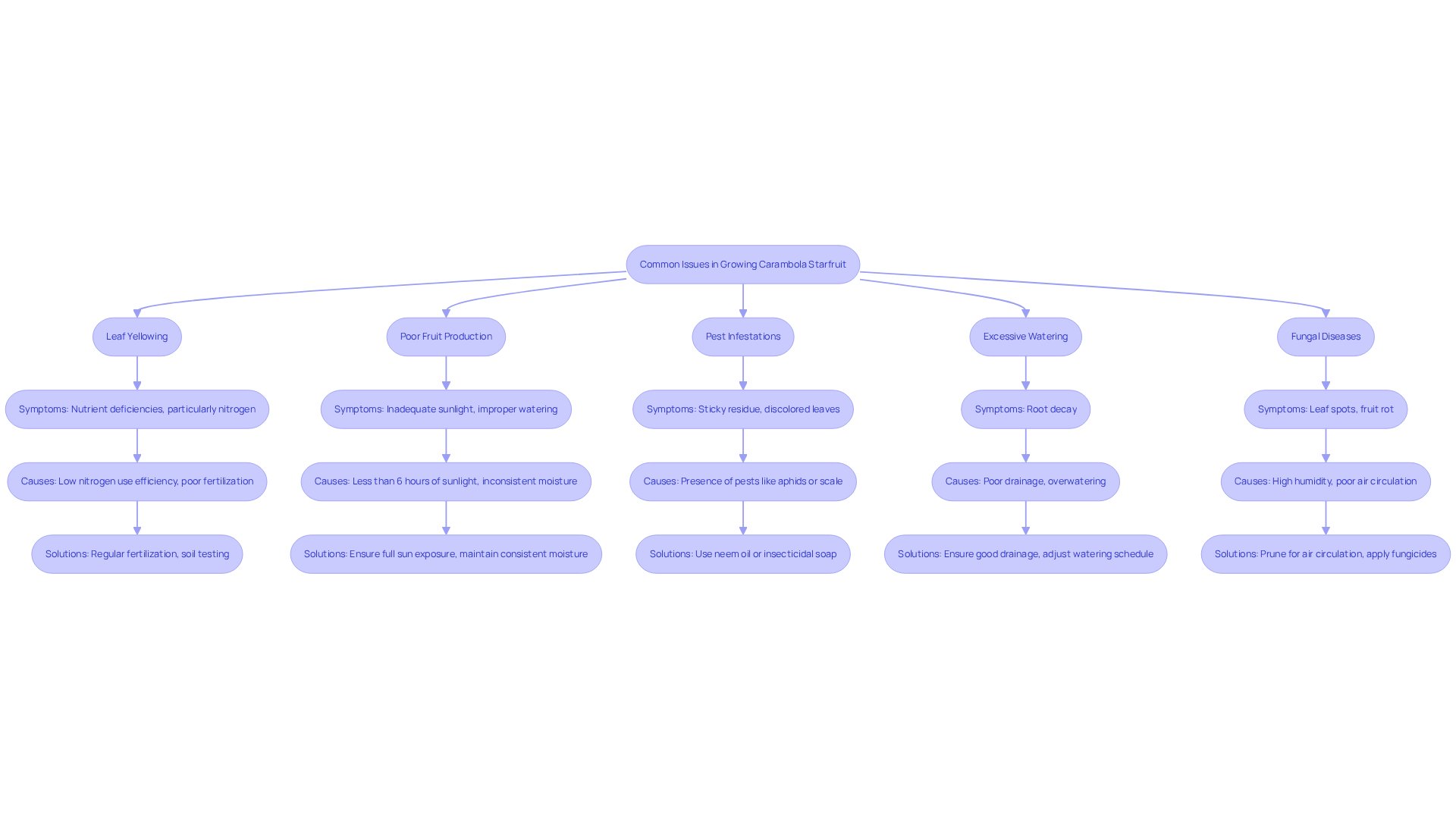
Master Carambola Starfruit: Essential Steps for Successful Growth
Share
Carambola starfruit, noted for its unique flavor and striking appearance, serves as a delightful addition to any garden. However, cultivating this tropical gem successfully necessitates a thorough understanding of its specific growing conditions, including optimal climate, soil requirements, and meticulous maintenance practices.
Gardeners may encounter various challenges when striving for a bountiful harvest. This guide explores essential strategies for troubleshooting common issues that arise during the growth process. By delving into the necessary steps for nurturing carambola starfruit, both novice and seasoned gardeners can reap the rewards of their efforts.
Thinking about growing a starfruit tree in your garden?
Explore Startfruit trees (Carambola) at Everglades Farm - shipped directly from Florida.
1. Understand the Growing Conditions for Carambola Starfruit
Carambola starfruit thrives in warm, tropical to subtropical climates, which are ideally suited for USDA hardiness zones 10 to 11. The optimal temperature range for its growth lies between 68°F and 95°F (20°C to 35°C). Selecting a planting site that receives full sun for at least six hours a day is crucial, as insufficient sunlight can impede fruit production. Additionally, the soil should be well-draining and slightly acidic, with a pH between 5.5 and 6.5. While consistent moisture is vital, it is important to avoid waterlogged conditions; Carambola plants can tolerate damp soil for short periods but may suffer from root rot if such conditions persist.
Mature carambola plants typically reach heights of 25 to 30 feet and spread 20 to 25 feet, making it essential to consider their space requirements during planting. Generally, these plants require about 2 to 4 years to yield fruit, so gardeners should plan accordingly. Once established, carambola plants exhibit moderate drought tolerance, necessitating only moderate watering to support healthy growth. Explore Everglades Farm's Fast-Growing Plants collection, which features a variety of tropical fruits, including the carambola starfruit, along with high-quality fertilizers designed to enhance your home gardening endeavors.

2. Plant Carambola Starfruit: Step-by-Step Instructions
-
Choose the Right Location: Selecting a sunny spot with well-draining earth is crucial. It should be situated away from other plants and structures to encourage sufficient air circulation. Starfruit trees thrive in full sunlight, requiring at least 6 hours of direct sunlight daily, ideally up to 8 hours in tropical climates.
-
Prepare the Ground: To enhance drainage and nutrient levels, improve the earth by incorporating organic material, such as compost. Aim for a soil pH between 5.5 and 6.5, as this range supports optimal growth and minimizes disease risks.
-
Dig the Hole: Create a hole that is twice as wide and as deep as the ball of roots. This spacious cavity promotes easy growth expansion, enabling the plant to establish itself effectively.
-
Plant the Sapling: Carefully take the sapling out of its container, gently loosening any circling growths. Place the plant in the hole, ensuring the top of the ball of roots is even with the surrounding earth. Backfill with earth and lightly tamp down to eliminate air pockets, promoting good contact with the material.
-
After planting, irrigate the plant deeply to assist in settling the earth around the roots. Maintain consistent moisture in the soil without overwatering, particularly during the early weeks as the plant establishes itself.
-
Fertilize Regularly: To promote optimal growth and yield, apply fertilizer to the plant 4 to 6 times annually with a balanced formula. This practice is essential for both carambola starfruit and soursop plants to thrive.
-
Prune as Needed: Pruning is essential for managing plant size and enhancing early fruit production. Regularly remove side branches and suckers to promote light and air circulation in the canopy. Applying these practices will also assist in managing pests organically, ensuring a healthy environment for both carambola starfruit and soursop plants.

3. Maintain Your Carambola Starfruit: Care and Maintenance Tips
-
Watering: Carambola plants thrive with consistent moisture, particularly during dry spells. It is advisable to irrigate thoroughly once a week, allowing the top inch of soil to dry out between waterings to prevent root decay.
-
Fertilization: To achieve optimal growth, apply a balanced, slow-release fertilizer every 2-3 months throughout the growing season. Mature plants should receive fertilization four to six times annually, while younger plants benefit from more frequent nourishment, approximately every 30-60 days, to support their rapid growth.
-
Ground Preparation: Prior to planting, ensure that the soil is well-drained and loosened to encourage healthy root development. A well-drained, loamy soil rich in organic matter is ideal for carambola starfruit plants.
-
Pruning: Annual pruning is crucial for maintaining the plant's shape and removing any dead or diseased branches. This practice not only promotes better air circulation but also enhances sunlight penetration, fostering healthier growth.
-
Pest Management: Regular inspections for pests such as scale insects, aphids, fruit flies, and mealybugs are essential. In the event of infestations, organic treatments like neem oil can effectively manage these pests while minimizing environmental impact.
-
Protection from Frost: In cooler climates, it is vital to protect young plants from frost damage. Shield them during cold spells or move potted plants indoors to ensure their survival and continued growth. Be mindful that temperatures below 35°F can be harmful to carambola starfruit plants.

4. Troubleshoot Common Issues in Growing Carambola Starfruit
-
Leaf Yellowing: This symptom often indicates nutrient deficiencies, particularly nitrogen. Regular fertilization is essential, as nitrogen use efficiency in fruit plants typically falls below 55%. Conducting a soil test can help determine pH levels and nutrient availability. Horticulturalists emphasize that maintaining balanced nutrition is vital for vibrant foliage and overall plant health.
-
Poor Fruit Production: Inadequate sunlight or improper watering can significantly hinder fruiting. Ensure your carambola starfruit plant receives full sun exposure for at least six hours daily and maintain consistent moisture without waterlogging. Additionally, nutrient deficiencies can adversely affect fruit quality and yield, making it crucial to monitor fertilization alongside sunlight and moisture.
-
Pest Infestations: If you notice sticky residue or discolored leaves, inspect for pests such as aphids or scale. Address infestations promptly with neem oil or insecticidal soap to protect your plant's health. Implementing integrated pest management strategies can further enhance your approach to pest control.
-
Excessive watering can lead to root decay, a common issue in carambola starfruit farming. Ensure your soil has good drainage, as poor drainage can exacerbate nutrient deficiencies and negatively impact tree health. Adjust your watering schedule to prevent water accumulation around the roots.
-
Fungal Diseases: Signs of leaf spots or fruit rot may indicate fungal infections. Enhance air circulation around the tree by pruning and spacing plants appropriately, and apply fungicides as necessary to manage these diseases effectively. Improving air circulation is crucial for reducing humidity around the foliage, which can help prevent fungal outbreaks.

Conclusion
Successfully cultivating carambola starfruit necessitates a thorough understanding of its growth requirements and effective maintenance techniques. By adhering to the outlined steps and guidelines, gardeners can establish an environment conducive to healthy growth and abundant yields. The synergy of optimal climate conditions, diligent planting procedures, and continuous care is crucial for achieving the best results.
Key considerations include:
- The significance of selecting a sunny location
- Preparing well-draining soil
- Ensuring consistent moisture without the risk of overwatering
- Regular fertilization and pruning to improve plant health and enhance fruit production
- Proactive pest management
- Addressing common challenges such as nutrient deficiencies and fungal diseases to safeguard the longevity and productivity of carambola starfruit plants
In conclusion, cultivating carambola starfruit can be a fulfilling endeavor for home gardeners. By implementing the practices detailed in this guide, individuals can savor the unique flavor of this tropical fruit while enhancing their gardening success. Embrace the journey of nurturing these vibrant plants and take pride in the satisfaction of harvesting your own starfruit, a true testament to your gardening expertise.
Grow Your Own Starfruit: Start Your Tropical Garden Today!
Join Everglades Farm and cultivate vibrant carambola trees with expert guidance and top-quality plants.
👉🏻 Explore starfruit tree collection
Frequently Asked Questions
What climate is ideal for growing carambola starfruit?
Carambola starfruit thrives in warm, tropical to subtropical climates, particularly in USDA hardiness zones 10 to 11.
What is the optimal temperature range for carambola growth?
The optimal temperature range for carambola growth is between 68°F and 95°F (20°C to 35°C).
How much sunlight do carambola plants need?
Carambola plants require full sun for at least six hours a day to ensure proper fruit production.
What type of soil is best for carambola starfruit?
The best soil for carambola starfruit is well-draining and slightly acidic, with a pH between 5.5 and 6.5.
How should watering be managed for carambola plants?
Consistent moisture is vital for carambola plants, but it's important to avoid waterlogged conditions. They can tolerate damp soil for short periods but may suffer from root rot if such conditions persist.
How tall and wide do mature carambola plants typically grow?
Mature carambola plants typically reach heights of 25 to 30 feet and spread 20 to 25 feet.
How long does it take for carambola plants to yield fruit?
Carambola plants generally require about 2 to 4 years to yield fruit after planting.
What is the drought tolerance of carambola plants?
Once established, carambola plants exhibit moderate drought tolerance and necessitate only moderate watering to support healthy growth.

